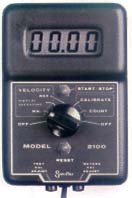MAIN MENU
CATALOG INDEX
BY ALPHABETICAL
ORDER
For more info:
JSi@jsits.com
- [ Price Type AA
Current Meter ]
- [
Pygmy Current Meter
]
- [ Electronic
Flowmeter
and
Readout ]
- [ Mechanical
Flowmeters
/ Model
2030 series ]
- [ Open
Channel / Sewer Flowmeter PCM3 ]
- [ Open
Stream Current
Velocity
Meter ]
- [ Salinomadd
Salt
Wave
Flowmeter
]
 The Model 2100 is a hand held current velocity meter designed
specifically for the measurement of open channel velocities.
The Model 2100 is a hand held current velocity meter designed
specifically for the measurement of open channel velocities.
- Efficient propeller-driven Photo-Fiber-Optic sensor coupled with precision quartz crystal controlled electronics provide accurate repeatable data in all flow conditions.
- The Model 2100 Indicator reads data in feet and meters per second. A toggle switch in the battery compartment changes from one to the other.
- Powered by a single 9 volt transistor battery.
- Three user selectable velocity averaging times in each mode. From 5 to 90 seconds in feet per second and from 1.5 to 30 seconds in meters mode.
- Sensor components (propeller, rotor, and rotor shaft) easily and inexpensively replaceable. Carry spares into remote locations and you'll never have to return early because of a bent bucketwheel, lost sensor magnet or bent shaft.
- Wide choice of sensor carriers or "wands" to accommodate virtually any open stream velocity measuring requirement.
- Lightweight, portable system is easy to work with all day in the field. Indicator weighs a little over a pound and a half.
- A simple and accurate method of user-accomplished calibration is provided with the Model 2100. No other current meter provides the user a method of checking and changing calibrations while in the field. Calibration settings for the feet and meters selection are easily checked and changed any time.
Optical-electronic sensor
The basic principle of the sensor is simple; multiple bundles of fiber-optics, assembled into a propeller rotor, gate a beam of infrared light from a photo diode to a photo-sensitive transistor. The rate of rotation of the propeller rotor is directly proportional to water speed, therefore, pulses produced by the photo transitor over a given time are also directly proportional to water velocity.
The Model 2100 uses a propeller rotor which requires very little energy to activate, works in nearly all water conditions and produces consistent, strong output pulses even at low speeds. The calibration curve for the rotors is linear and consistent in all normally occurring open channel velocities. The propellers used with the Model 2100 were specifically designed for use in water so they do not need a shroud to protect them from the effects of turbulence. Because no shroud is used the propellers are better able to shed and be cleaned of debris normally found in sewers and natural streams.
The electronic hlalf of the sensor (2100-A22) consists of the latest opto-electronics and is epoxy encapsulated in a 1/2" (12.7mm) diameter acetal resin housing for protection from chemicals and the elements. The sensor uses a two-wire signal system requiring only 3 volts for operation and can generate an output signal through over 1000 feet of cable. The sensor consumes very little power, produces four pulses per revolution and can be manufactured in a variety of configurations and, most of all, it is sturdy and reliable.
The standard version of the propeller rotor assembly (2100-A21) uses a very low friction fiber-optics rotor, a polished and hardened stainless steel shaft, and a 2" glass-filled nylon propeller. All rotor parts are easily replaceble in the field and spares are provided with every new instrument.
Specifications
- Velocity range: 0.1 to 25 feet per second (propeller
meters)
(0.03 to 7.5 meter per second) - Display: 4 digit, Liquid Crystal Digital, 7" digits
- Resolution: To hundredths, both feet and meters
- Accuracy: Can be held to within 1% with periodic user-required calibration tests and adjustments.
- Display averaging: Three selectable averaging times
- 5, 20 and 90 seconds-FPS mode.
- 1.5, 6 and 30 seconds-MPS mode.
- Operating temperature
- LCD
Min. -14°F (-25.6°C)
Max. 180°F (82°C) @ 15% humidity
Max. 120°F (49°C) @ 95% humidity - Sensor
Min. 0°F (-17.8°C)
Max. 300°F (149°C)
- LCD
- Power required: One 9 volt battery. Alkaline or rechargeable NiCad
- Indicator size: 4 by 6 by 2 inches (15.2 by 10.2 by 5.1 cm)
- Indicator weight: 25 oz. (including 9 volt batteries, one spare)
- Indicator material: Vacuum-formed ABS with a clear acrylic viewing lens over the LCD.
- Indicator keypad & switches: Back-printed polycarbonate in four colors plus black. Two pushbutton momentary switches, one rotary switch with silicone boots for water seal.
- Fasteners: Stainless Steel & Brass
- Sensor Wand materials: Aluminum = 6061-T6, Stainless Steel - #303
- Sensor body and rotor: Acetal-resin, carbon reinforced and machined from solid stock.
- Sensor propeller: Glass-filled nylon. 2" diameter is supplied. Other sizes are available for special applications.
- Electrical connection: Hyper-flexible PVC jacketed cable. Two-conductor sensor signal system. Circular plastic connector with twist-lock operation. Water resistant with gold plated contacts. Special cable types also available.
- Cable length: Equal to wand at full extension plus five feet. Special length to 1000'are also available.
- Sensor type: Photo-Fiber-Optic two-conductor electrical with all electronics permanently encapsulated in epoxy resin.